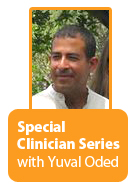Integrating mindfulness with biofeedback — A new way to enhance results in individual therapy — Introduction
Submitted by sv.admBy Yuval Oded, inspired by Zindel Segal

As mindfulness and other Eastern spiritual practices are introduced into psychotherapy, both therapists and clients seek for ways to deepen the practice. In the next few weeks I will describe how I integrate Alive biofeedback with mindfulness practices.
“Mindfulness” refers to keeping one’s consciousness alive to the present reality. John Kabat-Zinn, one of pioneers in integrating mindfulness into therapy, says, “when we use the term mindfulness we refer to ‘an openhearted, moment to moment, nonjudgmental awareness’.”
In therapy we often aim at helping our clients to promote acceptance of internal experience. In a wide range of clinical problems, what is common is the avoidance or over-attention to internal experiences such as thoughts, images, emotions and sensations. For example, many clients are not aware of the moment-to-moment fluctuations in mood they are experiencing. A patient may describe his panic attack as lasting 4 days while scientific findings show that the human body is not capable of sustaining such high levels of arousal for long. Anxiety sensitivity, or fear of fear, often causes this sustained attention to anxiety-related symptoms.
The process of trying to help our clients to pay attention to whatever arises internally or externally, without becoming hooked on the wish that things were otherwise, and diminishing avoidance behaviors is part of therapy.
Mindfulness practices within therapy include improving awareness through learning to focus one’s attention in a different way than our daily “jumpy” mode of attention. In this, we focus on first becoming aware of thoughts, emotions and bodily sensations as well as sounds , smells, tastes as they are. Another aspect of mindfulness is nonjudgmental observation, the ability to develop a sense of compassion towards one’s internal experience, becoming aware of one’s inner critic, learning to step back from it and notice experiences without labeling them good or bad. We try to cultivate a “beginner’s mind” that observes things as they are rather than letting what we “know” dominate our perceptions. By participating in experiences as they occur we teach our mind to observe the here-and-now rather than to keep on focusing on the past or the future. Learning to “stay in the moment” is not easy and requires many hours of practice. Many clients who are introduced to mindfulness skills, particularly early in treatment, find it difficult to see the value of these practices. Furthermore, those who are convinced they want to integrate these practices will often say to the therapist, “I intended to set aside some time for practice this week but I have too much else going on and it just did not happen.” Enhancing their motivation to practice is of extreme importance if we want to achieve changes of automatic patterns of the mind.
After many years of integrating mindfulness skill training with biofeedback I would like to share with you the wonderful benefits of combining both. In the coming weeks I will focus on the roles and benefits of using biofeedback at different stages of skill acquisition.
- Becoming aware of the mind body connection using Alive SCL screens
- Initial mindfulness breathing exercise with Alive breathing coach
- Attention modes training with Zoom Out ™, Change the Channel ™, and Mental Mini-Breaks™ feedback from Alive HRV and SCL graphing
- Body Scan training with Alive mindfulness workshop and SCL graph training (introducing the sweat stability graph)
- Cultivating mindfulness and acceptance using the Dream house, Green Thumb, and Four Seasons mini-games
- Opening our heart using Alive HRV graph training and games and Finding Gratitude and Trust workshop
- Mindful eating with biofeedback
- 5-Minute Daily Break with HRV and SCL screens
And lots more.
Feel free to contact me in this blog with any questions or feedback.


